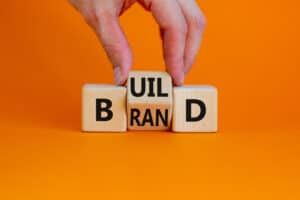When most people think about a blog post, they think about words. And the words in a post are critical—without high-quality writing, you haven’t got much.
In this post, though, we’re going to take a more holistic look at everything that turns a collection of words into a blog post.
Here’s a look at a recent blog posts from this blog (get your scrolling finger ready):

In this zoomed-out view, you really start to notice the many elements that make up this webpage. The page you saw above, much like the page you’re reading now, is our blog post template page, displaying the content of the blog post. A blog post template allows you to achieve a consistent look & feel across all of your blog posts, and keep common elements you want on all of your posts showing up (navigation, calls to action, etc).
It’s easy to get overwhelmed by the composite items in a blog post, but it’s actually quite simple—there are only four main components:
- Top navigation
- The post “hero” section
- The body content section
- The footer section
Let’s look at each of these components in detail and highlight key features and best practices of each.
But before we do, two things:
- Let’s quickly revisit the goals of business blogging so you can see how the anatomy of a blog post supports these goals: i) help tell your organization’s story, ii) increase your site’s digital footprint and the freshness of its content for SEO, iii) create content to answer specific prospect questions and target specific keywords for SEO, iv) take all of this traffic and a) begin to establish brand recognition for the visitors and b) capture leads and c) build audiences for remarketing (and any number of other blogging goals not detailed here).
- As a quick aside, if you’re looking at our template and features and thinking, “Damn, that’s a good looking template, but man, there’s no way I can make my blog do that!” fear not. Modern blogging platforms like WordPress, HubSpot, and Squarespace make it relatively easy to create a good looking blog template (all have marketplaces of free templates you can use) with the basic bells and whistles you need to turn words into fully functioning blog posts. Sometimes simple is best. (And if you’d like to learn more about why our template looks the way it does, check out the link.)
Top Navigation

The top navigation of your blog post should serve two purposes:
1. Branding! If you do your job right, your blog will be a source of brand new traffic to your site, and expose people to your brand for the first time, or remind them of your brand again. They may find your post on Google, read it, and then leave. But by focusing on brand in your top nav, you’ll put a little reminder in their head so next time they see your brand, they’ll remember it.
And that memory will buy you crucial trust.
2. Navigation. This is pretty obvious. But! Put yourself in the shoes of one of your prospects who just read one of your awesome blog posts and thought, “Wow, that was really useful/fun/interesting information. I wonder who wrote it?” A next logical step for that person is to poke around more on your website.
We’ll talk more about strategies to help users do that below, but your top nav is a logical place for many users to turn to when they want to know more.
The Post “Hero” Section

Your post hero section is the first piece of blog-post-specific information on your blog post template. Here’s its job:
- Provide a quick snapshot of what the post is about: its title, perhaps a supporting picture to serve as visual context
- Provide other supporting information
- The author (not necessary, but this definitely helps to make your blog more human & approachable!)
- The date (particularly important for topics that are time-sensitive or change over time—a recent date can help users know they’re getting the best information and enables the site to feel more dynamic)
- Topics—provides further context around your post, provides an opportunity for navigation to other similar content
Hero section tip: Keep it short and clean! Allow your reader to get to the content quickly, without too much noise or distraction.
The Body Content

- Calls-to-Action (CTAs) allow you to turn your blog readers into leads. A couple of best practices to keep in mind with CTAs: 1) balance making your CTAs “pop” so readers will see them with ensuring your CTAs aren’t too aggressive or annoying, 2) make the offer in your CTA relevant to the content, 3) CTAs come in many forms— pop-ups, in-line CTAs (like an ad within your content), or fly-in, sticky CTAs—this is what we’re using in this post.
- External & Internal Links. As a best practice your blog posts should contain two types of links: 1) external links (to other websites) provide additional resources for your readers and credibility for you, and 2) internal links provide other relevant resources on your website to keep readers engaged with your brand.
- Pictures provide visual accompaniment to your post and allow you to use image alt-tags for SEO purposes.
- Section Headers divide up your blog post into sections and make it more scannable.
- Sharing Buttons make it easy for readers to share content they’re into. We like sharing buttons that “float” alongside content to make sharing always within reach.
The Footer Section

The footer section is all about providing your readers with recommendations on what to do next.
- About the Author provides more context into who wrote the post to humanize your blog. It can also link to other content by that author on your website.
- CTA/Form: your footer section provides another opportunity for placement of a CTA/form to get readers interacting with your business.
- Related Posts. If someone made it all the way to the bottom of your blog post, they must like what they’re reading! A related posts section can provide guidance on what they should read next (and get more eyeballs on your other awesome content pieces!).
- Website Footer Navigation. Your blog should feel like it’s part of your website, so include the footer navigation that exists on your site on your blog template. In addition to branding, this provides another navigation opportunity for your readers.
Wrapping Up
There you have it—the big building blocks and functional components of a blog post. As you design a blog for your business, keeping these in mind will turn your blog from a collection of words into a digital ambassador for your brand and a lead generation machine!



